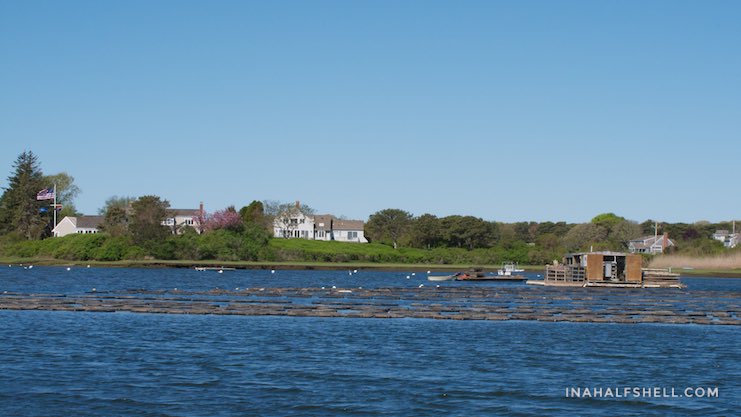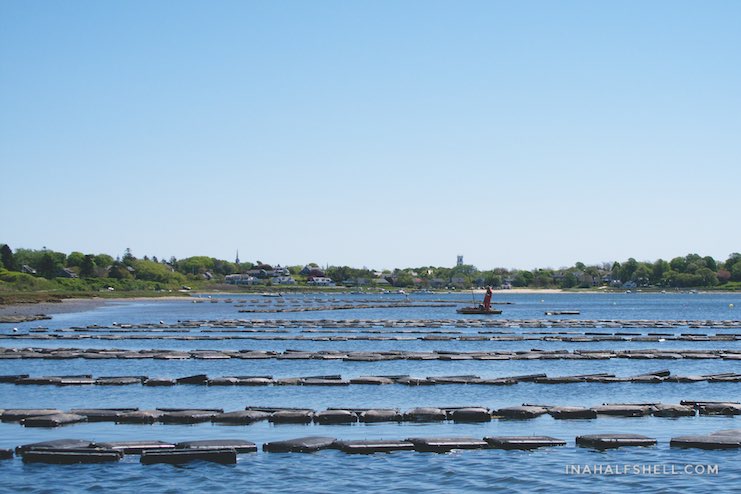Cape Cod Oyster Tour Continues at Chatham Shellfish
You are probably familiar with the phrase, “The world’s your oyster,” but I am here to convince you that the oyster can also be your world.
Over the last five years, I have traveled for oysters. There’s nothing quite like savoring them straight out of the water, and I have spent a lot of time seeking these briny morsels out all over the world. For my latest adventure, I had the opportunity to shadow Steve Wright, the farm manager for Chatham Shellfish Company on Cape Cod, Massachusetts a few weeks ago.
Cape Cod is one of the great American oyster farming regions. The bracingly cold, nutrient-rich waters and ample ocean tides help create prime aquaculture environments. Chatham Shellfish Farm stretches for several acres in Oyster Pond, a saltwater pond (33ppt) historically celebrated for its abundant oyster beds. This productive, and beautiful body of water is connected to the Atlantic Ocean through the Nantucket Sound and Oyster River (as seen below). This area of Cape Cod enjoys 5-7 ft tides, which is enough to power their upwellers naturally.
Today, Chatham Shellfish Company is the only commercial oyster farm in the area, but several oyster shanty’s still remain by the boat launch. Owner John Richards purchased the grant in 1976 and experimented with several species of shellfish. After much trial and error, he arrived at oysters. Steve came to work at Chatham Shellfish pretty much straight out of school. He studied at the University of Maine and also received training in aquaculture at the Bridgeport Aquaculture School. The appeal of creating a sustainable, domestic food supply was what got him interested in the field in the first place.
After a quick tour of the processing room, it was time to hop on board the aqua-colored boat. A big blue bin in the middle was for the ice slurry, an important feature to note. As soon as Steve's oysters are lifted from the water, they're on a timer. In accordance with Massachusetts shellfish harvest regulations (see 3a), all oysters that are going to market must be packed and put on ice within 2 hours during the summer season. This is to help reduce the proliferation of vibrio.
Steve offered me a pair of boots, which I stupidly declined. No matter how many farms I visit, I never seem to be properly dressed for the occasion. The sunshine was lovely, but the wind chill was not. You can't tell from these photos, but it was actually quite cold!
We first passed by a cluster of Oystergro cages that belonged to Chatham's shellfish department. The town has a longstanding Propagation Program which is intended to maintain and replenish commercial and recreational shellfish stocks for locals and visitors. About 100k oysters are grown out in these cages as seen above, which are later dispersed around the area like easter eggs. Anyone can apply for a seasonal "family" license. The fee is $35 if you're a resident and $100 if you're not. If I had more time on the Cape, I would totally apply for one of these. :-)
A few minutes later we reached a floating oyster house in the middle of the pond. The custom-built structure stores most of the farm’s grow out and processing equipment. Before this, I thought that I had seen the most eclectic collection of gear out in Wellfleet with the Puffers. I think a new record has been set! Chatham Shellfish uses the full spectrum of grow out equipment... from traditional rack and bags to floating trays to Oystergro cages to open trays lined in a row. They even bottom plant. I lost count after the sixth or seventh form.
Steve gave me a quick rundown of their farming process, which begins with planting oyster seed that’s just a few millimeters long. The seed is kept in a series of upwellers that sit just below the water surface in Oyster Pond and Oyster River. They leverage the natural tidal flow to move water and phytoplankton up and over the voracious baby oysters. Once the juvenile oysters grow to a certain size, they are transferred to nearby grow-out areas.
Steve "Popeye the Oyster Man" and Brad "Golden Gorilla" work daily with the oysters.
This one line of tray required a rather athletic approach to launch into the water. (See: https://instagram.com/p/3B_7CIOIVM)
Steve fills the big blue bin with ice and seawater, making an instant slurry for refrigeration.
Following the farm tour, we returned back to the floating platform for the tasting portion of the visit. We pulled out a handful of large 3+ inch Chatham oysters and placed them on the well-worn sorting table.
Steve side-shucked a few of the larger oysters open. “I prefer side-shucking because it allows less interference with the belly,” he explained.
I had a surprise for Steve: I lifted a couple bottles of premium sake out of my handbag, including Yuho “Eternal Embers” Junmai and Fukucho “Moon on the Water” Junmai Ginjo. It’s still a well-kept secret in this country that sake happens to be one of the most exquisite and complementary pairing for oysters.
The blissfully sweet and savory Chatham oysters were out of this world, and they paired splendidly with the sakes. Every bite tasted fresh and alive. I happily jotted my tasting notes down in my new 33 Oyster journal.
By the time we had eaten our fill, the tide was on its way out. Areas that once appeared empty now popped with lines of oysters.
Many thanks to Steve and John for giving me a peek inside your farm!




















